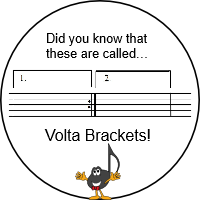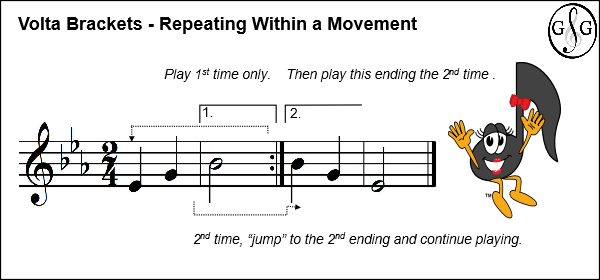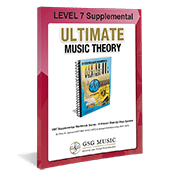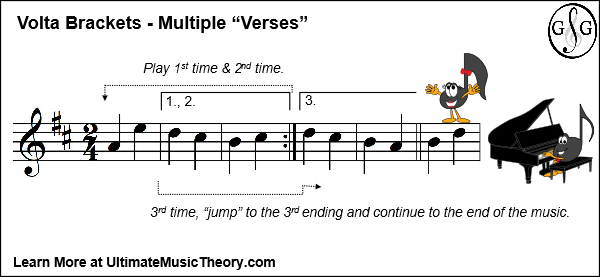Volta Brackets

"Volta Brackets", also called "Time Bars" or "First and Second Ending Brackets", are horizontal brackets that are written above the staff. They are often labeled with numbers or letters.
Volta Brackets are used when a part, excerpt or passage of music is to be played two or more different times (repeats) but with two or more different endings.
Volta Brackets can be used within the music or at the end of the music. Volta Brackets also use specific Bar Lines to clarify their purpose.
Volta Brackets Within a Movement
When a First and Second Ending occurs within a movement (or within a piece of music), First and Second Ending Volta Brackets can be used as a form of "Musical Shorthand"!
The performer plays the First Ending, goes back to the beginning of the music (following the Repeat Sign) and then plays again.
The Second Time through, the performer skips the First Ending and goes directly to the Second Ending.

When the Volta Brackets are within a Movement (the Second Ending is not the final measure of the music):
- The First Ending (the First Volta Bracket) is a closed bracket. The First Ending will end with a Repeat Sign.
- The Second Ending (the Second Volta Bracket) is an open bracket (an open ended bracket) - there is no final "down line" at the end of the bracket. The final measure of the Second Ending can either use a double bar line (two thin bar lines) to show that it is the end of that "section" OR it can simply use a single bar line as the music continues.
Volta Brackets at the End of the Music
When a First and Second Ending is required at the end of the music, the performer plays the First Ending, then goes back to the beginning of the music (following the Repeat Sign) and plays again. The Second Time through, the performer skips the First Ending and goes directly to the Second Ending.
When the Volta Brackets are at the End of the Music (the Second Ending is the final measure):
- The First Ending (the First Volta Bracket) is a closed bracket. The First Ending will end with a Repeat Sign.
- The Second Ending (the Second Volta Bracket) is also a closed bracket. The Second Ending will end with a Double (Final) Bar Line.

Ti-Do Tip: Volta Brackets - or First and Second Ending Brackets - do not touch the staff. They are written directly above the staff. They are aligned vertically with the bar lines for each of the endings. When writing Volta Brackets, be certain to NOT let any part of the music (articulation, dynamics or any other musical element) touch the Volta Brackets.
There can also be more than one measure of music below each Volta Bracket. The Volta Bracket simply extends to cover the measures played in each Ending.

Students learn about Volta Brackets in the Ultimate Music Theory LEVEL 7 Supplemental Workbook on page 49.
Successful completion of the UMT LEVEL 7 Supplemental Workbook (after completing the Intermediate Rudiments Workbook and the LEVEL 6 Supplemental Workbook) will prepare students for the RCM Level 7 Theory Examination (using the 2016 Theory Syllabus Edition).
In the Syllabus, Students learn that "volta" means "time". For example, "prima volta" means "first time" and "seconda volta" means "second time.
Although the term "Volta Brackets" is not part of the Syllabus, it is important for Students to learn the actual musical term for those First Ending and Second Ending Brackets.
Volta Brackets with Multiple "Verses"
We often find that, especially in Vocal Music, a section is played three or more times, but there are only two endings. The numbers written underneath the Volta Brackets indicate the number of times that ending is used.
In this example, students would play:
- measures 1 to 3 (first ending),
- measures 1 to 3 (second ending),
- measure 1 and then measures 4 & 5 (third ending), continuing on until the actual end of the music.

Volta Brackets with Multiple "Endings"
It is possible to have three different endings to a section (or a piece of music). These Multiple Volta Brackets are treated the same as a First Ending, Second Ending and Third Ending.
When this occurs in music, a Right Facing Repeat Sign will often be found at the beginning of the section (or the beginning of the piece of music) as a reminder that there will be multiple repeats. (Not sure what a "Right Facing Repeat Sign" is? Check out my blog on Repeat Sign Dots.)

This "musical shorthand" allows for repeating (with different endings) without rewriting entire sections of music. When you "play and sing" the above example, you will sing:
"This is ending one; This is ending two; This is ending three and done!"
At Ultimate Music Theory, we are passionate about teaching theory correctly. If you are a Teacher and you are not 100% Confident in your Theory Foundation, I would strongly recommend that you purchase the Complete Music Theory Course.
This Online Complete Music Theory Course is a series of 24 Videos that will guide you through each concept in the Ultimate Music Theory Complete Rudiments Workbook in an easy step-by-step system as you see, hear and complete each exercise.
There is a Mid-Term Examination and a Final Examination that you complete, scan and submit for marking. And, if you have any questions along the way, we are here to support you.
There is no time limit to finish this Course. When you purchase the Course, you have unlimited access to your Complete Music Theory Course Material. What are you waiting for?
Discover how you can teach music theory easily.
Join the Ultimate Music Teachers Membership - CLICK HERE TO LEARN MORE
Keep on Learning... With a Smile and a Song!
Shelagh McKibbon-U'Ren


